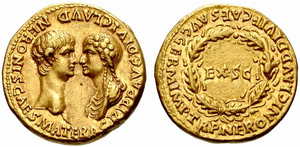This article needs additional citations for verification. (February 2016) |
| Millennium: | 1st millennium |
|---|---|
| Centuries: | |
| Decades: | |
| Years: |
| AD 59 by topic |
|---|
| Leaders |
| Categories |
| Gregorian calendar | AD 59 LIX |
| Ab urbe condita | 812 |
| Assyrian calendar | 4809 |
| Balinese saka calendar | N/A |
| Bengali calendar | −534 |
| Berber calendar | 1009 |
| Buddhist calendar | 603 |
| Burmese calendar | −579 |
| Byzantine calendar | 5567–5568 |
| Chinese calendar | 戊午年 (Earth Horse) 2756 or 2549 — to — 己未年 (Earth Goat) 2757 or 2550 |
| Coptic calendar | −225 – −224 |
| Discordian calendar | 1225 |
| Ethiopian calendar | 51–52 |
| Hebrew calendar | 3819–3820 |
| Hindu calendars | |
| - Vikram Samvat | 115–116 |
| - Shaka Samvat | N/A |
| - Kali Yuga | 3159–3160 |
| Holocene calendar | 10059 |
| Iranian calendar | 563 BP – 562 BP |
| Islamic calendar | 580 BH – 579 BH |
| Javanese calendar | N/A |
| Julian calendar | AD 59 LIX |
| Korean calendar | 2392 |
| Minguo calendar | 1853 before ROC 民前1853年 |
| Nanakshahi calendar | −1409 |
| Seleucid era | 370/371 AG |
| Thai solar calendar | 601–602 |
| Tibetan calendar | 阳土马年 (male Earth-Horse) 185 or −196 or −968 — to — 阴土羊年 (female Earth-Goat) 186 or −195 or −967 |

AD 59 (LIX) was a common year starting on Monday (link will display the full calendar) of the Julian calendar. At the time, it was known as the Year of the Consulship of Apronianus and Capito (or, less frequently, year 812 Ab urbe condita). The denomination AD 59 for this year has been used since the early medieval period, when the Anno Domini calendar era became the prevalent method in Europe for naming years.